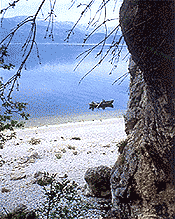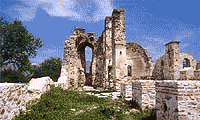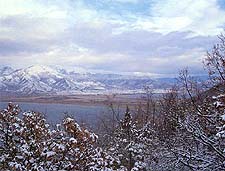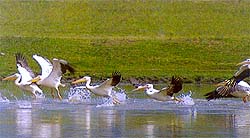Florina, the prefectural capital, is spread out over a hillside covered with wild chestnut trees.
 Aminteo, a modern market town, lies 41 kilometers from Florina, while 6 kilometers from there, on the shores of Lake Vegoritis, there is the picturesque village of Aghios Panteleimonas, where an ancient settlement and cemetery have been excavated.
Aminteo, a modern market town, lies 41 kilometers from Florina, while 6 kilometers from there, on the shores of Lake Vegoritis, there is the picturesque village of Aghios Panteleimonas, where an ancient settlement and cemetery have been excavated.
Nimfeo (53 km. from Florina), on the slopes of Mt. Vitsi (alt.1,350m.), is both a winter and summer resort, with delightful houses built in the local style.
Further up the mountain in the village of Pissoderi (alt. 1,420m.), where are Viglaski center is located. The part of this prefecture that holds the greatest interest for visitors, whether Greek of foreign, is its two lakes, which form the natural borders of Greece with Albania and the former Yugoslavia.
The part of this prefecture that holds the greatest interest for visitors, whether Greek of foreign, is its two lakes, which form the natural borders of Greece with Albania and the former Yugoslavia.
These lakes, Mikri and Megali Prespa are situated 850 meters above sea level and are separated by a narrow strip of land.
The shores of the smaller lake are filled with reeds that every year provide shelter for many kinds of birds. Looking as though it is floating in the middle of the lake is the islet of Aghios Ahilios, with both ancient and Byzantine ruins; its rocky coast harbours caves once used as shrines, whose walls are decorated with religious paintings.
On the shores of Megali Prespa, which may be either steep or rocky of flat and lush, there is a delightful little village called Psarades, which is very reminiscent of an Aegean hamlet with its characteristic architecture. Here, as well as at Aghios Germanos, where there is a byzantine church dedicated to St. Germands with excellent frescoes, one will find tavernas serving freshly caught fish from the lakes. Niki (17 km. north of Florina) is one of the country’s exit-entry posts.
 Aminteo, a modern market town, lies 41 kilometers from Florina, while 6 kilometers from there, on the shores of Lake Vegoritis, there is the picturesque village of Aghios Panteleimonas, where an ancient settlement and cemetery have been excavated.
Aminteo, a modern market town, lies 41 kilometers from Florina, while 6 kilometers from there, on the shores of Lake Vegoritis, there is the picturesque village of Aghios Panteleimonas, where an ancient settlement and cemetery have been excavated.Nimfeo (53 km. from Florina), on the slopes of Mt. Vitsi (alt.1,350m.), is both a winter and summer resort, with delightful houses built in the local style.
Further up the mountain in the village of Pissoderi (alt. 1,420m.), where are Viglaski center is located.
 The part of this prefecture that holds the greatest interest for visitors, whether Greek of foreign, is its two lakes, which form the natural borders of Greece with Albania and the former Yugoslavia.
The part of this prefecture that holds the greatest interest for visitors, whether Greek of foreign, is its two lakes, which form the natural borders of Greece with Albania and the former Yugoslavia.These lakes, Mikri and Megali Prespa are situated 850 meters above sea level and are separated by a narrow strip of land.
The shores of the smaller lake are filled with reeds that every year provide shelter for many kinds of birds. Looking as though it is floating in the middle of the lake is the islet of Aghios Ahilios, with both ancient and Byzantine ruins; its rocky coast harbours caves once used as shrines, whose walls are decorated with religious paintings.
On the shores of Megali Prespa, which may be either steep or rocky of flat and lush, there is a delightful little village called Psarades, which is very reminiscent of an Aegean hamlet with its characteristic architecture. Here, as well as at Aghios Germanos, where there is a byzantine church dedicated to St. Germands with excellent frescoes, one will find tavernas serving freshly caught fish from the lakes. Niki (17 km. north of Florina) is one of the country’s exit-entry posts.
Lake Mikri Prespa & Lake Megali Prespa
Lake Mikri Prespa is a Ramsar site (8,000 ha), Special Protection Area and Specially Protected Mediterranean Area. Both lakes form a National Park (19,470 ha).
It is about two lakes of a mountain drain basin that are split by a narrow land strip and are surrounded by mountains. Greece is sharing Lake Mikri Prespa with Albania and Lake Megali Prespa with Albania and F.Y.R.O.M. Lake Mikri Prespa has several extended shallow zones with reedbeds and aquatic vegetation, wet meadows, pastures and agricultural land. The main human activities are agriculture, fishery and hunting. In 1985 the Greek Government launched a development pilot program that was financed by the European Union and was aimed to develop agriculture, aquaculture and to extend the road network. The result was a serious ecological damage that was caused by the cutting of the remaining riverine forest, the clearing with dredging machines of the canals that were rich in aquatic vegetation and the creation of a fish pond in a vital feeding site for herons. This fishpond was never put into service.
Greece is sharing Lake Mikri Prespa with Albania and Lake Megali Prespa with Albania and F.Y.R.O.M. Lake Mikri Prespa has several extended shallow zones with reedbeds and aquatic vegetation, wet meadows, pastures and agricultural land. The main human activities are agriculture, fishery and hunting. In 1985 the Greek Government launched a development pilot program that was financed by the European Union and was aimed to develop agriculture, aquaculture and to extend the road network. The result was a serious ecological damage that was caused by the cutting of the remaining riverine forest, the clearing with dredging machines of the canals that were rich in aquatic vegetation and the creation of a fish pond in a vital feeding site for herons. This fishpond was never put into service.
It is the only place in Europe (except for the Danube Delta and the former U.S.S.R.) that both White Pelicans Pelecanus onocrotalus and Dalmatian Pelicans Pelecanus crispus breed. In 1984 their populations were, respectively, 116 and 165 pairs and these numbers are rather stable for the last 10 years. The numbers of herons (Ardeidae) were fluctuating (some species showed a decline) and include the Little Bittern Ixobrychus minutus (50 pairs), the Squacco Heron Ardeola ralloides (50-100 pairs), the Little Egret Egretta garzetta (fewer than 100 pairs), the Great White Egret Egretta alba (fewer than 10 pairs) and the Purple Heron Ardea purpurea (3 pairs). Glossy Ibis Plegadis falcinellus does not breed any more.
The numbers of herons (Ardeidae) were fluctuating (some species showed a decline) and include the Little Bittern Ixobrychus minutus (50 pairs), the Squacco Heron Ardeola ralloides (50-100 pairs), the Little Egret Egretta garzetta (fewer than 100 pairs), the Great White Egret Egretta alba (fewer than 10 pairs) and the Purple Heron Ardea purpurea (3 pairs). Glossy Ibis Plegadis falcinellus does not breed any more.
Other breeding species are the Cormorant Phalacrocorax carbo sinensis (600 pairs), the Pygmy Cormorant Phalacrocorax pygmeus (100-150 pairs), the Spoonbill Platalea leucorodia (2 pairs, at former times the maximum number was 200 pairs), the Grey Goose Anser anser (maximum 170 pairs, the main breeding site in Greece), the Ferruginous Duck Aythya nyroca (10 pairs), the Goosander Mergus merganser and the Red-breasted Merganser Mergus serrator (small population, the southernmost area in Europe and the only one in Greece), the Egyptian Vulture Neophron percnopterus, the Short-toed Eagle Circaetus gallicus (2 pairs), the Marsh Harrier Circus aeruginosus, the Golden Eagle Aquila chrysaetos (2 pairs), the Hazel Grouse Bonasa bonasia (one of the few areas in Greece), the Rock Partridge Alectoris graeca, the Whiskered Tern Chlidonias hybridus, the Kingfisher Alcedo atthis, the Medium Spotted Woodpecker Dendrocopos medius, and the Lesser Grey Shrike Lanius minor. At winter, thousands of ducks are recorded, despite the freezing of the lakes.
It is about two lakes of a mountain drain basin that are split by a narrow land strip and are surrounded by mountains.
 Greece is sharing Lake Mikri Prespa with Albania and Lake Megali Prespa with Albania and F.Y.R.O.M. Lake Mikri Prespa has several extended shallow zones with reedbeds and aquatic vegetation, wet meadows, pastures and agricultural land. The main human activities are agriculture, fishery and hunting. In 1985 the Greek Government launched a development pilot program that was financed by the European Union and was aimed to develop agriculture, aquaculture and to extend the road network. The result was a serious ecological damage that was caused by the cutting of the remaining riverine forest, the clearing with dredging machines of the canals that were rich in aquatic vegetation and the creation of a fish pond in a vital feeding site for herons. This fishpond was never put into service.
Greece is sharing Lake Mikri Prespa with Albania and Lake Megali Prespa with Albania and F.Y.R.O.M. Lake Mikri Prespa has several extended shallow zones with reedbeds and aquatic vegetation, wet meadows, pastures and agricultural land. The main human activities are agriculture, fishery and hunting. In 1985 the Greek Government launched a development pilot program that was financed by the European Union and was aimed to develop agriculture, aquaculture and to extend the road network. The result was a serious ecological damage that was caused by the cutting of the remaining riverine forest, the clearing with dredging machines of the canals that were rich in aquatic vegetation and the creation of a fish pond in a vital feeding site for herons. This fishpond was never put into service.It is the only place in Europe (except for the Danube Delta and the former U.S.S.R.) that both White Pelicans Pelecanus onocrotalus and Dalmatian Pelicans Pelecanus crispus breed. In 1984 their populations were, respectively, 116 and 165 pairs and these numbers are rather stable for the last 10 years.
 The numbers of herons (Ardeidae) were fluctuating (some species showed a decline) and include the Little Bittern Ixobrychus minutus (50 pairs), the Squacco Heron Ardeola ralloides (50-100 pairs), the Little Egret Egretta garzetta (fewer than 100 pairs), the Great White Egret Egretta alba (fewer than 10 pairs) and the Purple Heron Ardea purpurea (3 pairs). Glossy Ibis Plegadis falcinellus does not breed any more.
The numbers of herons (Ardeidae) were fluctuating (some species showed a decline) and include the Little Bittern Ixobrychus minutus (50 pairs), the Squacco Heron Ardeola ralloides (50-100 pairs), the Little Egret Egretta garzetta (fewer than 100 pairs), the Great White Egret Egretta alba (fewer than 10 pairs) and the Purple Heron Ardea purpurea (3 pairs). Glossy Ibis Plegadis falcinellus does not breed any more.Other breeding species are the Cormorant Phalacrocorax carbo sinensis (600 pairs), the Pygmy Cormorant Phalacrocorax pygmeus (100-150 pairs), the Spoonbill Platalea leucorodia (2 pairs, at former times the maximum number was 200 pairs), the Grey Goose Anser anser (maximum 170 pairs, the main breeding site in Greece), the Ferruginous Duck Aythya nyroca (10 pairs), the Goosander Mergus merganser and the Red-breasted Merganser Mergus serrator (small population, the southernmost area in Europe and the only one in Greece), the Egyptian Vulture Neophron percnopterus, the Short-toed Eagle Circaetus gallicus (2 pairs), the Marsh Harrier Circus aeruginosus, the Golden Eagle Aquila chrysaetos (2 pairs), the Hazel Grouse Bonasa bonasia (one of the few areas in Greece), the Rock Partridge Alectoris graeca, the Whiskered Tern Chlidonias hybridus, the Kingfisher Alcedo atthis, the Medium Spotted Woodpecker Dendrocopos medius, and the Lesser Grey Shrike Lanius minor. At winter, thousands of ducks are recorded, despite the freezing of the lakes.

